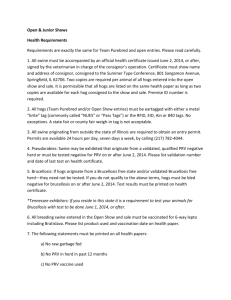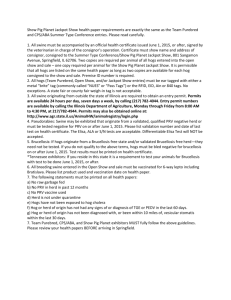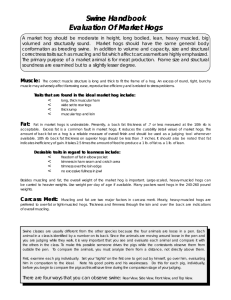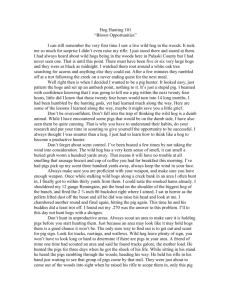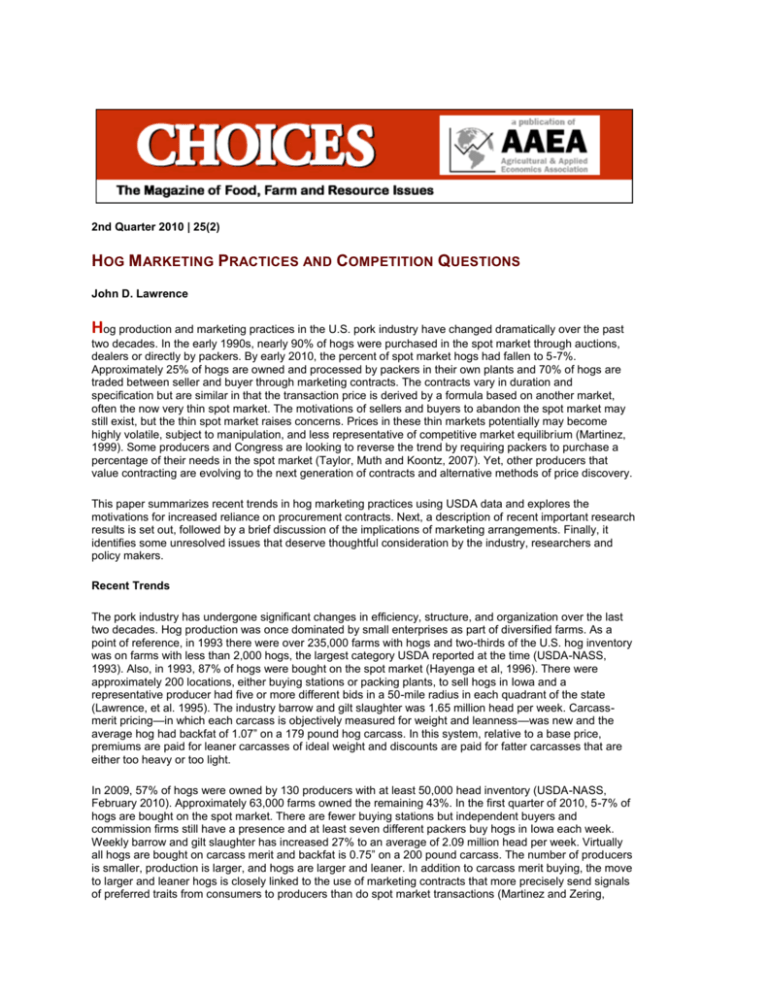
2nd Quarter 2010 | 25(2)
HOG M ARKETING PRACTICES AND COMPETITION QUESTIONS
John D. Lawrence
Hog production and marketing practices in the U.S. pork industry have changed dramatically over the past
two decades. In the early 1990s, nearly 90% of hogs were purchased in the spot market through auctions,
dealers or directly by packers. By early 2010, the percent of spot market hogs had fallen to 5-7%.
Approximately 25% of hogs are owned and processed by packers in their own plants and 70% of hogs are
traded between seller and buyer through marketing contracts. The contracts vary in duration and
specification but are similar in that the transaction price is derived by a formula based on another market,
often the now very thin spot market. The motivations of sellers and buyers to abandon the spot market may
still exist, but the thin spot market raises concerns. Prices in these thin markets potentially may become
highly volatile, subject to manipulation, and less representative of competitive market equilibrium (Martinez,
1999). Some producers and Congress are looking to reverse the trend by requiring packers to purchase a
percentage of their needs in the spot market (Taylor, Muth and Koontz, 2007). Yet, other producers that
value contracting are evolving to the next generation of contracts and alternative methods of price discovery.
This paper summarizes recent trends in hog marketing practices using USDA data and explores the
motivations for increased reliance on procurement contracts. Next, a description of recent important research
results is set out, followed by a brief discussion of the implications of marketing arrangements. Finally, it
identifies some unresolved issues that deserve thoughtful consideration by the industry, researchers and
policy makers.
Recent Trends
The pork industry has undergone significant changes in efficiency, structure, and organization over the last
two decades. Hog production was once dominated by small enterprises as part of diversified farms. As a
point of reference, in 1993 there were over 235,000 farms with hogs and two-thirds of the U.S. hog inventory
was on farms with less than 2,000 hogs, the largest category USDA reported at the time (USDA-NASS,
1993). Also, in 1993, 87% of hogs were bought on the spot market (Hayenga et al, 1996). There were
approximately 200 locations, either buying stations or packing plants, to sell hogs in Iowa and a
representative producer had five or more different bids in a 50-mile radius in each quadrant of the state
(Lawrence, et al. 1995). The industry barrow and gilt slaughter was 1.65 million head per week. Carcassmerit pricing—in which each carcass is objectively measured for weight and leanness—was new and the
average hog had backfat of 1.07” on a 179 pound hog carcass. In this system, relative to a base price,
premiums are paid for leaner carcasses of ideal weight and discounts are paid for fatter carcasses that are
either too heavy or too light.
In 2009, 57% of hogs were owned by 130 producers with at least 50,000 head inventory (USDA-NASS,
February 2010). Approximately 63,000 farms owned the remaining 43%. In the first quarter of 2010, 5-7% of
hogs are bought on the spot market. There are fewer buying stations but independent buyers and
commission firms still have a presence and at least seven different packers buy hogs in Iowa each week.
Weekly barrow and gilt slaughter has increased 27% to an average of 2.09 million head per week. Virtually
all hogs are bought on carcass merit and backfat is 0.75” on a 200 pound carcass. The number of producers
is smaller, production is larger, and hogs are larger and leaner. In addition to carcass merit buying, the move
to larger and leaner hogs is closely linked to the use of marketing contracts that more precisely send signals
of preferred traits from consumers to producers than do spot market transactions (Martinez and Zering,
2004).
Another change that occurred since the early 1990s which allowed producers to grow was the use of
production contracts. The owner of the hogs pays a grower to provide the building, utilities and labor to raise
hogs to slaughter weight with the owner retaining ownership of the hogs, providing the feed, veterinary
supplies and management decisions and standing price risk in the feed and hog markets. According to
USDA, the total number of hogs under production contract owned by operations with over 5,000 head, but
raised by contractees, accounted for 44% of the total U.S. hog inventory (USDA-NASS, March 2010). While
often confused and used interchangeably, it is important to recognize the difference between production
contracts and marketing contacts. Production contracts make provision for payments from the
contractor/hog-owner to the grower/contractee for the housing and other costs associated with raising the
hogs. Payments under the terms of the contract are relatively stable providing reduced risk for the grower.
Marketing contracts are used to transfer ownership of the hogs from the hog owner to the buyer—typically a
packer/processor. The focus of this paper is on marketing contracts.
Between 1993 and 2002, spot market share of hog sales decreased from 87% to 17% and fell to 5-7% of
barrow and gilt slaughter by 2010. Packer-owned hogs going to their own plant represents 26% of hogs
marketed, while some form of marketing contracts accounted for approximately 60% of the market hogs sold.
The largest single market contract category is “hog or pork market formula” meaning that the transaction
price in the contract is tied to the spot market for hogs or wholesale pork.
The spot market represents 5-7% of the hogs marketed or approximately 20,000-30,000 head on a given
day. Prices under USDA-Mandatory Price Reporting (MPR) are reported twice a day, mid-morning and midafternoon meaning that the price reported represents an even smaller number of hogs and transactions. With
the small number of transactions per reporting period the potential for greater price volatility from one market
report to the next increases as does the possibility that individual transactions can unduly impact prices
higher or lower. Some hog marketing contracts base the hog price on wholesale pork prices. While in this
formula the producer price increases when the packer price increases, the wholesale pork market is also
thinly reported and is not covered under the current MPR legislation. The contracts may also include a
“quality” adjustment to address the concern that spot market hogs are not representative of all hogs. Parties
to the contract often use multi-day or weekly averages to reduce volatility impacts of thin markets. However,
there is concern that if packer controlled supplies, owned or contracted, can be used to pressure the spot
market lower, then the contract prices are lower as well. The impact on overall price levels resulting from
price discovery involving a small number of hogs is discussed later.
Motivation for Marketing Contracts
The trend to increased use of hog marketing contracts to procure hogs was driven by both producers and
packers. Consumers were asking for leaner and more consistent pork. New hog production technologies
such as artificial insemination, lean genetics, phase and split-sex feeding and age segregated rearing,
reduced costs of production and allowed large producers, in particular, to capture scale economies at the
farm level. Transportation efficiencies, dedicated feed mills, and management skills generated scale
economies at the firm level. Producers capturing the early adopter margins used production contracts to
expand proven management and production systems. However, lenders were reluctant to loan to modernize
facilities or expand without assurances of market access and in some cases price risk management. A
producer survey conducted in 2000 found that increased price and reduced price risk were identified as the
most important relevance of marketing contracts following disastrously low prices in 1998-1999 (Lawrence
and Grimes, 2001).
At the same time packers saw changing production practices and investments made in regions distant from
the traditional Midwest hog belt and existing packing facilities. In addition to securing a more consistent,
uniform supply of higher quality hogs for the life of the contract, packers gained other advantages that the
spot market never evolved sufficiently to deliver (Lawrence, Schroeder and Hayenga, 2001). Marketing
contracts are a form of nonprice competition for hogs that encourage production facility investment near
packing facilities by assuring lenders that hog producers have access guaranteed to packer “shackle-space”.
The terms of some contracts also provide for less hog price or margin risk. Packers competed with one
another on contract terms that either impacted the base price, carcass-merit premiums or risk-sharing
methods. Risk sharing provisions varied by company, but typically involved the producer giving up
opportunity for possibly higher spot market prices in return for contract protection from low spot market
prices. For a discussion of hog marketing contracts see Lawrence (1999).
USDA-AMS, through Mandatory Price Reporting, reports number of head, carcass characteristics and prices
by purchase method. The risk sharing provisions of the contracts are evident in average annual prices
(Figure 1). The spot market price is higher than contracts in some years, but lower in others. Marketing
contracts typically have specifications that require producers to adopt industry standard best management
practices and encourage production of leaner hogs, the primary measure of quality, among other
characteristics. The hogs sold through the spot market on average are not as lean as hogs sold under
contract and have lower value in today’s buying systems.
Relevant Research
Compared to the fed cattle market, there have been relatively few studies on the implications of market
power—the ability of a firm or firms to influence price that is not possible in a perfectly competitive market—in
the hog market. In a simulation model, Wang and Jaenicke (2006) found that for formula-price contracts
increased contract supplies are negatively related to the expected spot market price when participating
producers contract high proportions—greater than 0.8—of their hogs. However, they are positively related
when producers contract lower proportions—between 0.6 and 0.8. Moreover, increased contract supplies
reduce the variance of spot market price under formula-price contracts. They also found that formula-price
contracts offer the highest expected profit to processors and highest expected utility to producers. The results
imply that as long as a producer has a sufficient number of hogs in the spot market for negotiation that
contracting the remainder can be beneficial. Too few in the spot market and they lose their leverage.
However, in today’s market many producers contract all of their production and other producers do not
contract any and thus the simulation results may not fit with today’s market reality. Finally, the authors
conclude that important linkage between the contract market and the cash market could disappear if cash
markets become too thin and disappear altogether. With spot market volume near 5%, the sector may be at
that point.
Perhaps the most comprehensive analysis of alternative marketing arrangements (AMA) in recent years is
the Livestock and Meat Marketing Study (RTI International, 2007). AMAs are defined as an alternative to the
spot market and include packer ownership and marketing contracts. Analyzing transaction data for October
2002 through March 2005 the authors found that on average packers that use a combination of marketing
arrangements pay lower prices than slaughter facilities that use the spot market only. The RTI analysis found
a statistically significant presence of market power by buyers to influence prices in live hog procurement.
However, the results regarding the significance of AMA use for procurement of live hogs in explaining the
sources of that market power are inconclusive; i.e., packers might have market power, but that power does
not derive from AMA’s. Thus, restricting AMAs is no assurance that market power will diminish.
There has been legislation proposed to restrict packer ownership and the use of marketing contracts. Some
proponents of restrictions mistakenly cite the relationship between the change in AMAs and the change in
hog prices reported in the RTI report as proof that hog prices would be higher with a larger spot market. The
authors found that during the time period of the study, contracts had a bigger impact on price than did packer
ownership. A 1% increase in contract hog quantities causes the spot market price to decrease by 0.88% and
a 1% increase in packer-owned hog quantities causes the spot market price to decrease by 0.28%. What is
often ignored is that if the same hogs are put on the spot market that price will decrease 0.27% with each 1%
increase in the supply of spot market hogs. In recent years U.S. hog slaughter has been slightly more than
100 million hogs, 63 million contract hogs, 32 million packer-owned hogs and 5 million spot-market hogs.
Thus, a 1% decrease in contract marketings (630,000 annually) will increase the spot market price 0.88%.
But, if the hogs are shifted to the spot market, they will increase that supply by 12.6% depressing prices by
3.4%. The math is similar, but not as dramatic for packer ownership. The point is that unless restricting
contracts and packer ownership also restricts production, the hogs will simply be sold through the spot
market increasing its supply and, at least in this analysis, offsetting the price increase associated with
restricting AMAs. If, in fact, some producers are dependent on procurement contracts to secure financing as
they were in the 1990s, then restrictions on contracts could force some operations out of business and
thereby reducing pork supplies.
The RTI authors also modeled the vertical chain from hog farms to consumers. They factored in the cost
advantages that packers have in operating their plants more efficiently when using AMAs and the impact on
consumer demand from producing higher quality pork through AMAs—improved ability to deliver consumer
preferred traits, such as uniformity, leanness, color, etc. They concluded that restrictions on the use of AMAs
in the hog and pork industries would result in a net loss to both producers and consumers. Hog producers
would lose because of the offsetting effects of hogs diverted from AMAs to the spot market, some increased
costs of plant operations shifted back to producers and the decrease of consumer demand due to declining
quality. Consumers would lose as wholesale and retail pork prices rose due to smaller supplies and some of
the higher packer costs were passed downstream. Packers would gain in the short run, but neither gain nor
lose in the long run as they operate a margin business between producers and consumers.
Remaining Questions
Hog marketing practices have changed with the evolution of the industry and have provided motivation to
both producers and packers to use marketing contracts rather than the spot market. Yet many hog marketing
contracts rely on the spot market for price discovery leaving important questions worthy of consideration. For
example, what are the necessary conditions for a viable spot market and what criteria define “viable”? What
is the source of market power and what is the cost of controlling it? What are the effects of restricting
marketing contracts? If producer loans are contingent upon marketing contracts, what is that impact on asset
values if there are forced liquidations because marketing contracts are restricted? Likewise, what happens to
the value of facilities if packers have put their production operations on the market at a time when other
producers are selling farms and lenders are reluctant to loan without marketing contact assurances?
While the previous questions focused on implications of the spot market disappearing or of restrictions to
force hogs back into the spot market, there are equally challenging questions regarding an alternative to the
spot market. What will be the characteristics of the next generation of hog marketing contracts? Is marketbased price discovery relevant in an industry that integrates producers more closely with consumers? What
are the competition implications if the market trades contracts rather than hogs?
Whether trading hogs or contracts, issues of market performance and conduct remain. The USDA, Grain
Inspection, Packers and Stockyards Administration (GIPSA) is proposing to add several new sections to the
regulations under the Packers and Stockyards Act, 1921. The new regulations that GIPSA is proposing
would describe and clarify conduct that violates the P&S Act and allow for more effective and efficient
enforcement by GIPSA. Additional research and development are called for to find workable solutions to
industry questions particularly in the context of the proposed regulatory changes.
For More Information
Hayenga, M., V.J. Rhodes, G. Grimes and J.D. Lawrence. (February 1996). Vertical Coordination in Hog
Production, GIPSA-RR 96-5, May 1996. Results also summarized as Chapter 5 in Concentration in the Red
Meat Packing Industry, Packers and Stockyards Programs, GIPSA, U.S. Department of Agriculture.
Lawrence, John, Zhi Wang, Marvin Hayenga, and Laura Sternweis. (July 1995). "The Changing Hog
Slaughter Industry and Buyer Competition in Iowa." Iowa State University Extension P-1356, Revised.
Lawrence, John (1999). Understanding Hog Marketing Contracts. Available online
athttp://econ2.econ.iastate.edu/faculty/lawrence/Acrobat/LemanConf1999mc.pdf
Lawrence, John and G. Grimes. (August 2001). "Production and Marketing Characteristics of U.S. Pork
Producers, 2000." (Ames, Iowa State University, Department of Economics): Staff Paper No. 343. Available
online at http://www.econ.iastate.edu/faculty/lawrence/Acrobat/Staffppr343FNL.pdf
Lawrence, John, T. Schroeder and M. Hayenga. (2001). "Evolving Producer-Packer-Customer Linkages in
the Beef and Pork Industries." Review of Agricultural Economics 23:370-385.
Martinez, S.W. (April 1999). Vertical Coordination in the Pork and Broiler Industries: Implications for Pork and
Chicken Products. Agricultural Economics Report No. 777. U.S. Department of Agriculture, Economic
Research Service.
Martinez, S.W. and K. Zering. (November 2004). Pork Quality and the Role of Market Organization.
Agricultural Economic Report No. 835. U.S. Department of Agriculture, Economic Research Service.
RTI International. (2007). Livestock and Meat Marketing Study. Final report prepared for the Grain
Inspection, Packers and Stockyards Administration, U.S. Department of Agriculture. Research Triangle Park.
Taylor, J., M. Muth, and S. Koontz. (November 2007). Livestock and Meat Marketing Arrangements:
Background on Proposed Livestock Marketing Arrangements Legislation, LM-1. Livestock Marketing
Information Center. Available online at http://www.lmic.info/memberspublic/LMMA/LM1%20Fact%20Sheet_legislation.pdf
U.S. Department of Agriculture National Agricultural Statistical Service. (December 1993). Hogs and Pigs.
U.S. Department of Agriculture National Agricultural Statistical Service. (March 2010). Hogs and Pigs.
U.S. Department of Agriculture National Agricultural Statistical Service. (February 2010). Farms, Land in
Farms, and Livestock Operations.
Wang, Y., and E.C. Jaenicke. (November 2006). “Simulating the Impacts of Contract Supplies in a Spot
Market-Contract Market Equilibrium Setting.” American Journal of Agricultural Economics 88: 1062-1077.
John D. Lawrence (jdlaw@iastate.edu) is a Professor of Economics and Associate Dean and Director of
Agricultural and Natural Resources Extension, Iowa State University, Ames, Iowa.
© 1999-2010 Choices. All rights reserved. Articles may be reproduced or electronically distributed as long as
attribution to Choices and the Agricultural & Applied Economics Association is maintained.



